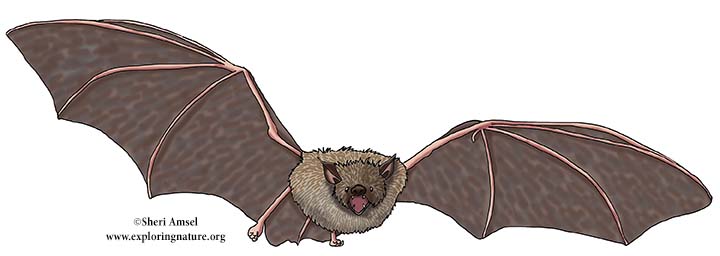

They live in the western North America from southwestern Canada, through the western U.S. to western Mexico.
They are found in habitats near water (lakes, ponds, rivers and streams) from coniferous forests to dry, scrubby habitats.
A small bat, weighing less than 1/4 of an ounce, they have tan-colored fur, that is lighter underneath than on top. They have a wingspan of less than ten inches. The ears are medium long with pointed tops and a pointed tragus in front.
Yuma myotis come out at sunset to hunt for insects flying low over the water and using echolocation. Within a couple of hours they are fed, drink water and return to the roost. They roost under bridges, in caves and old mines, in hollow trees, and in abandoned buildings and attics that are close to water. In some locations they roost with large numbers of other bats. They spend the winter hibernating (in torpor).
They eat insects, flying low over the water and shoreline at sunset. Scientists estimate that they can eat half their weight in insects nightly.
They may be killed by owls or hawks hunting near the water at sunset.
Females gather in breeding colonies in the spring and give birth to a single baby (pup) in May-June. The males do not help with young.
Yuma myotis have been affected by white-nose syndrome, a deadly fungal disease that has hurt so many North American bat species. Though they are listed on the IUCN Red list as "least concern" the fungal disease may affect their long term populations.
Related Resources:
Coloring Page
Labeling Page
High Resolution Diagram
Kingdom: Animalia
Phylum: Chordata
Class: Mammalia
Order: Chiroptera
Family: Vespertilionidae
Genus: Myotis
Species: M. yumanensis
When you research information you must cite the reference. Citing for websites is different from citing from books, magazines and periodicals. The style of citing shown here is from the MLA Style Citations (Modern Language Association).
When citing a WEBSITE the general format is as follows.
Author Last Name, First Name(s). "Title: Subtitle of Part of Web Page, if appropriate." Title: Subtitle: Section of Page if appropriate. Sponsoring/Publishing Agency, If Given. Additional significant descriptive information. Date of Electronic Publication or other Date, such as Last Updated. Day Month Year of access < URL >.
Amsel, Sheri. "Bat (Yuma Myotis)" Exploring Nature Educational Resource ©2005-2024. December 13, 2024
< http://www.exploringnature.org/db/view/Yuma-myotis >

